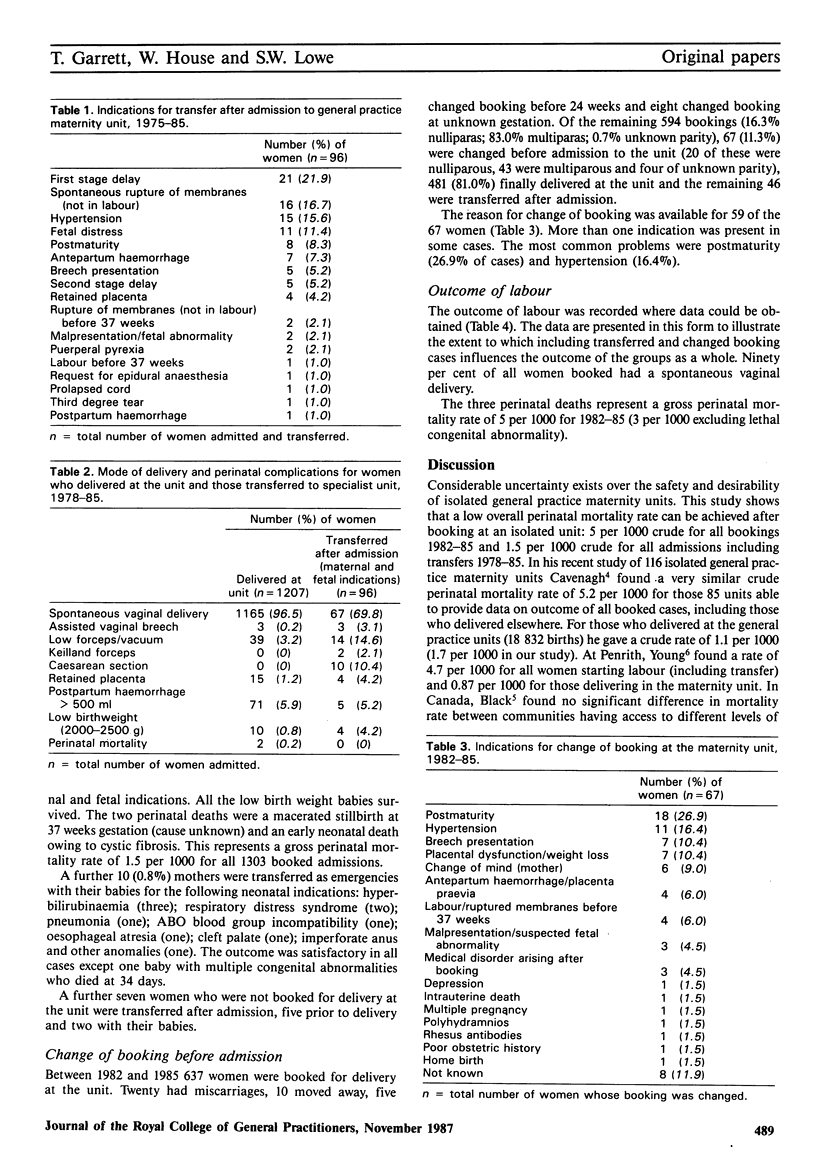Abstract
The outcome of pregnancy of 1303 women admitted for delivery (including those transferred after admission) at an isolated general practitioner maternity unit over the period 1978-85 was studied. The outcome following change of booking before admission was also assessed for the years 1982-85. The crude perinatal mortality rate was 1.5 per 1000 for all admissions between 1978 and 1985. Of the women admitted in 1978-85 7.4% were transferred after admission while for those booked at the unit in 1982-85 11.3% had their place of booking changed. A higher proportion of nulliparous women than multiparous women were transferred or had their place of booking changed. The main reasons for transfer after admission were delay in the first stage of labour (21.9%), spontaneous rupture of membranes not in labour (16.7%) and hypertension (15.6%), and for change of booking postmaturity (26.9%) and hypertension (16.4%).
Sufficient information concerning risk of transfer and change of booking may now be available from studies of isolated general practice maternity units for pregnant women at low risk to make an informed choice of place for delivery.
Full text
PDF


Selected References
These references are in PubMed. This may not be the complete list of references from this article.
- Black D. P., Fyfe I. M. The safety of obstetric services in small communities in northern Ontario. Can Med Assoc J. 1984 Mar 1;130(5):571–576. [PMC free article] [PubMed] [Google Scholar]
- Campbell R., MacFarlane A. Place of delivery: a review. Br J Obstet Gynaecol. 1986 Jul;93(7):675–683. [PubMed] [Google Scholar]
- Cavenagh A. J., Phillips K. M., Sheridan B., Williams E. M. Contribution of isolated general practitioner maternity units. Br Med J (Clin Res Ed) 1984 May 12;288(6428):1438–1440. doi: 10.1136/bmj.288.6428.1438. [DOI] [PMC free article] [PubMed] [Google Scholar]
- Klein M., Lloyd I., Redman C., Bull M., Turnbull A. C. A comparison of low-risk pregnant women booked for delivery in two systems of care: shared-care (consultant) and integrated general practice unit. I. Obstetrical procedures and neonatal outcome. Br J Obstet Gynaecol. 1983 Feb;90(2):118–122. doi: 10.1111/j.1471-0528.1983.tb08894.x. [DOI] [PubMed] [Google Scholar]
- Lowe S. W., House W., Garrett T. Comparison of outcome of low-risk labour in an isolated general practice maternity unit and a specialist maternity hospital. J R Coll Gen Pract. 1987 Nov;37(304):484–487. [PMC free article] [PubMed] [Google Scholar]
- Rosenblatt R. A., Reinken J., Shoemack P. Is obstetrics safe in small hospitals? Evidence from New Zealand's regionalised perinatal system. Lancet. 1985 Aug 24;2(8452):429–432. doi: 10.1016/s0140-6736(85)92747-3. [DOI] [PubMed] [Google Scholar]
- Taylor A. Maternity services: the consumer's view. J R Coll Gen Pract. 1986 Apr;36(285):157–160. [PMC free article] [PubMed] [Google Scholar]
- Taylor G. W., Edgar W., Taylor B. A., Neal D. G. How safe is general practitioner obstetrics? Lancet. 1980 Dec 13;2(8207):1287–1289. doi: 10.1016/s0140-6736(80)92348-x. [DOI] [PubMed] [Google Scholar]
- Young G. Are isolated maternity units run by general practitioners dangerous? Br Med J (Clin Res Ed) 1987 Mar 21;294(6574):744–746. doi: 10.1136/bmj.294.6574.744. [DOI] [PMC free article] [PubMed] [Google Scholar]


